
 SCT-IPE5100
SCT-IPE5100
HDMI 2.0/USB AV over IP Encoder 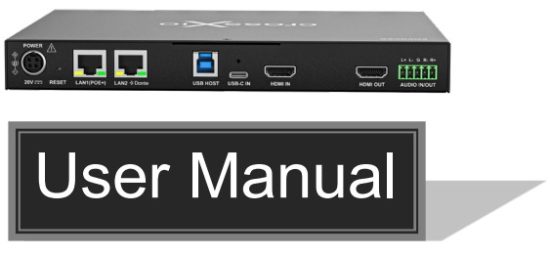 All Rights Reserved
All Rights Reserved
Version: SCT-IPE5100_2025 V1.0.0
SCT-IPE5100 HDMI 2.0 USB AV over IP Encoder
Preface
Read this user manual carefully before using the product. Pictures shown in this manual are for reference only. Different models and specifications are subject to real product.
This manual is only for operation instruction, please contact the local distributor for maintenance assistance. The functions described in this version were updated till June, 2021. In the constant effort to improve the product, we reserve the right to make functions or parameters changes without notice or obligation. Please refer to the dealers for the latest details.

SAFETY PRECAUTIONS
To ensure the best from the product, please read all instructions carefully before using the device. Save this manual for further reference.
- Unpack the equipment carefully and save the original box and packing material for possible future shipment.
- Follow basic safety precautions to reduce the risk of fire, electrical shock and injury to persons.
- Do not dismantle the housing or modify the module. It may result in electrical shock or burn.
- Using supplies or parts not meeting the products’ specifications may cause damage, deterioration or malfunction.
- Refer all servicing to qualified service personnel.
- To prevent fire or shock hazard, do not expose the unit to rain, moisture or install this product near water.
- Do not put any heavy items on the extension cable in case of extrusion.
- Do not remove the housing of the device as opening or removing housing may expose you to dangerous voltage or other hazards.
- Install the device in a place with fine ventilation to avoid damage caused by overheat.
- Keep the module away from liquids.
- Spillage into the housing may result in fire, electrical shock, or equipment damage. If an object or liquid falls or spills on to the housing, unplug the module immediately.
- Do not twist or pull by force ends of the cable. It can cause malfunction.
- Do not use liquid or aerosol cleaners to clean this unit. Always unplug the power to the device before cleaning.
- Unplug the power cord when left unused for a long period of time.
- Information on disposal for scrapped devices: do not burn or mix with general household waste, please treat them as normal electrical wastes.
Introduction
1.1. Overview
The SCT-IPE5100 series encoders are designed to work with SCT-IPD5100 series decoders for UHD media up to 3840 x 2160@60Hz 4:4:4 to be switched and distributed over standard Gigabit Ethernet networks, providing complete end-to-end streaming systems, where audio, video together with USB signals can be routed separately or as a whole. Equipped with Dante technology, they realize perfect interconnectivity and interoperability with Dante audio systems.
Dual Ethernet ports are equipped. HDCP 2.2/2.3 specifications are employed. A local area network is covered with a range up to 330ft (100m) over a single Cat 5e cable or above. Independent analog audio input/output is included. Control methods of Telnet/SSH/REST API and SCT-IPCX controller are provided. The encoders are ideal for any low latency and signal routing applications, such as homes, classrooms, conference rooms, sport bars, auditoriums, etc.
1.2. Features
- Includes one HDMI and one USB-C inputs with support of flexible input switching modes: Auto, Manual and Priority.
- The USB-C input supports DP 1.3 to HDMI 2.0, local USB 3.0 & remote USB 2.0 transmission, Ethernet pass-through and up to 100W charging.
- Built-in dual Ethernet ports, any one of which can be used for transmission of A/V streams, control data and Dante audio streams.
- The USB-B host port supports local USB 3.0 & remote USB 2.0 transmission, and Ethernet pass-through.
- Two USB type-A ports support USB 3.0 transmission with data rate up to 5Gbps.
- Supports input and output resolutions up to 3840 x 2160@60Hz 4:4:4.
- Supports HDR10 and Dolby Vision.
- Supports CEC.
- Supports multi-channel audio up to PCM 7.1, Dolby Atmos, DTS HD Master and DTS:X.
- Configurable audio input/output direction.
- HDMI ARC audio return.
- HDCP 2.2/2.3 compliant.
- Flexible routing policies, allowing audio, video and USB signals to be routed separately or as a whole throughout the matrix system.
- Delivers audio, video, USB and power signals up to 328ft/100m over a single Cat 5e cable or above.
- Supports point-to-point, point-to-multipoint, multipoint-to-point, multipoint- to-multipoint applications.
- Supports PoE to be remotely powered by compatible power source equipment such as a PoE-enabled Ethernet switch, eliminating the need for a nearby power outlet.
- Supports DHCP by default, and will fall back to AutoIP if there’s no DHCP server in the system.
- Controlled by Telnet/SSH/REST API and IP controller.
- Supports communications protocols of Telnet, SSH, HTTP, and HTTPS.
- Supports 2 x 2 Dante audio transmission.
1.3. Package Contents
- 1 x Encoder
- 1 x 3.5mm 5-Pin Phoenix Male Connector
- 4 x Mounting Brackets
- 4 x Screws
- 1 x User Manual
1.4. Specifications
| Video | |
| Input Video Port | 1 x USB-C; 1 x HDMI Type A (19 pins) |
| Input Video Type | HDMI 2.0, HDCP 2.2/2.3 |
| Input Resolutions | 3840 x 2160p@24/25/30/50/60Hz 4:4:4, 1920 x 1200@50/60Hz, 2400x1350p@60Hz, 1920 x 1080p@24/25/30/50/60/100/120Hz, 1920 x 1080i@50/60Hz, 1680 x 1050@60Hz, 1600 x 1200@60Hz, 1600 x 900@60Hz, 1400 x 1050@60Hz, 1440 x 900@60Hz, 1366 x 768@60Hz, 1360 x 768@60Hz, 1280 x 1024@60Hz, 1280 x 960@60Hz, 1280 x 800@60Hz, 1280 x 768@60Hz, 1280 x 720p@60/100/120Hz, 1024 x 768@60Hz, 800 x 600@60Hz, 720 x 576p@50Hz, 720 x 480p@60Hz, 640 x 480p@60Hz |
| Output Video Port | 2 x RJ-45; 1 x HDMI Type A (19 pins) |
| Output Video Type | IP Stream; HDMI 2.0, HDCP 2.2/2.3 |
| Output Resolutions | Up to 3840 x 2160p@60Hz 4:4:4 |
| Average Encoding Data Rate | 3840 x 2160@60Hz: 650Mbps (avg) / 900Mbps (max) |
| Input/Output Video Signal | 0.5~1.2 V p-p |
| Input/Output DDC Signal | 5 V p-p (TTL) |
| Video Impendence | 100 Ω |
| Maximum Data Rate | 18 Gbps (6 Gbps per color) |
| Maximum Pixel Clock | 600 MHz |
| Audio | |
| Input Audio Port | 1 x USB-C; 1 x HDMI Type-A; 1 x 3.5mm 5-pin phoenix connector (configurable) |
| Input Audio Signal | ● HDMI/USB-C IN: Fully supports audio formats in HDMI 2.0 specification, including PCM 2.0/5.1/7.1, Dolby TrueHD, Dolby Atmos, DTS-HD Master Audio and DTS:X ● AUDIO IN: Analog |
| Output Audio Port | 2 x RJ-45; 1 x HDMI; 1 x 3.5mm 5-pin phoenix connector (configurable) |
| Output Audio Signal | ● LAN/HDMI: Fully supports audio formats in HDMI 2.0 specification, including PCM 2.0/5.1/7.1, Dolby TrueHD, Dolby Atmos, DTS-HD Master Audio and DTS:X ● AUDIO OUT: Analog |
| Dante Audio Type | LPCM 2.0, 44.1/48/88.2/96 KHz |
| USB | |
| USB-C | ● USB Compliance: USB 3.0 (Local: USB 3.0, Remote: USB 2.0) ● Max USB Data Rate: 5Gbps ● Charging Compliance: PD 3.0 ● Max Charging Power: 100W ● Max Ethernet Data Rate: 1Gbps |
| USB-B | ● USB Compliance: USB 3.0 (Local: USB 3.0, Remote: USB 2.0) ● Max USB Data Rate: 5Gbps ● Max Ethernet Data Rate: 1Gbps |
| USB-A | ● USB Compliance: USB 3.0 ● Max USB Data Rate: 5Gbps ● Max Charging Power: 5V@3.0A (Two USB-A ports share a total current output of 3.0A) |
| Control | |
| Control Method | Telnet/SSH/REST API, IP Controller |
| General | |
| Operating Temperature/Humidity | 32°F ~ 113°F (0°C ~ 45°C), 10% ~ 90%, non-condensing |
| Storage Temperature/ Humidity | -4°F ~ 158°F (-20°C ~ 70°C), 10% ~ 90%, non-condensing |
| Power | 20V DC 10A; PoE+ |
| Power Consumption (Max) | 135W (with 100W charging included) |
| ESD Protection | Human body model: ±8kV (air-gap discharge) / ±4kV (contact discharge) |
| Dimensions (W x H x D) | 8.46” x 0.98” x 6.30” (215 mm x 25 mm x 160 mm) |
| Net Weight | 2.22lbs (1.01kg) |
1.5. Panel Descriptions
Front Panel
| # | Name | Description |
| 1 | POWER LED | ● On: The device is powered on. ● Blinking: The device is booting. ● Off: The device is powered off. |
| 2 | STATUS | ● On: The device is working properly. |
| LED | ● Blinking: The device is connected to the network but doesn’t detect valid signal input. ● Blinking slowly: The device is being upgraded. ● Blinking quickly: Find me function is activated through Telnet/SSH/REST API for positioning a certain device. For more information refer to the separate API document. ● Off: The device is not connected to the network. |
|
| 3 | USB-C |
● On: The USC-C charging function is available. ● Off: The USB-C charging function is not available. |
| 4 | USB-C IN LED | ● On: The corresponding input channel is selected, and a valA/V signal is detected. ● Blinking: The corresponding input channel is selected, andthere is a 5V signal input, but no valid A/V signal is detected ● Off: The corresponding input channel is not selected. / The corresponding input channel is selected but no 5V signal idetected. |
| 5 | HDMI LED | |
| 6 | USB 3.0 | 2 x USB 3.0 (5Gbps) Type-A ports. Connect to USB peripherals for USB extension or roaming. Note: Two USB-A ports share a total current output of 3.0A. |
Rear Panel

| # | Name | Description |
| 1 | 20V | DC 20V power connector. Connect to a DC 20V 10A power adapter for power input. |
| 2 | RESET Recessed Button | ● Short press (for not more than 1 second) then release to reboot the device. ● Press and hold for at least five seconds then release to reset the device to its factory default values. Note: When the settings are restored, your custom data is lost. Therefore, exercise caution when using the RESET button. |
| 3 | LAN1 (POE+) | By default, each of the LAN1 (POE+) and LAN 2 ports can be connected to an Ethernet switch for transmission of A/V streams, Dante audio streams and control data. For LAN1 (POE+): ● Supports PoE+. For LAN2: ● When LAN2 is configured as an independent Dante port**, it is for transmission of Dante audio streams, and LAN1 (POE) is for transmission of A/V streams and control data. Note: **This configuration can be implemented through the IP controller (SCT-IPCX). For more information, refer to the controller’s Web UI configuration guide. IMPORTANT: To prevent network loop, do not connect both ports to the same network. Ensure that each port is connected to a separate and distinct network. |
| 4 | LAN2 | |
| 5 | USB HOST | Connect the USB-B port to a computer for remote USB 2.0 and/or local USB 3.0 transmission, as well as for Ethernet pass-through. |
| 6 | USB-C IN | Connect the USB-C port to a USB-C source. This port supports transmission of DP 1.3, HDMI 2.0, remote USB 2.0 and/or local USB 3.0, Ethernet pass-through, as well as up to 100W charging. Tip: Charging of the attached peripheral is available only if this device is powered by the DC power instead of by PoE+. |
| 7 | HDMI IN | 19-Pin HDMI Type-A port. Connect to an HDMI source. This port supports HDMI 2.0b, HDCP 2.3 and bandwidth to themaximum of 18G. |
| 8 | HDMI OUT | 19-Pin HDMI Type-A connector. Connect to an HDMI display. |
| 9 | AUDIO IN/OUT | 5-Pin 3.5mm phoenix connector for balanced analog audio input or output. This port can be configured as AUDIO IN or AUDIO OUT through API commands. ● AUDIO IN: Connect to an audio source for audio input. ● AUDIO OUT: Connect to an audio receiver for audio output. Default setting: AUDIO OUT |
Installation
Note: Before installation, ensure the device is disconnected from the power source.
Steps to install the device on a suitable location:
- Attach the mounting brackets to the panels of both sides using the screws (two on each side) provided in the package.
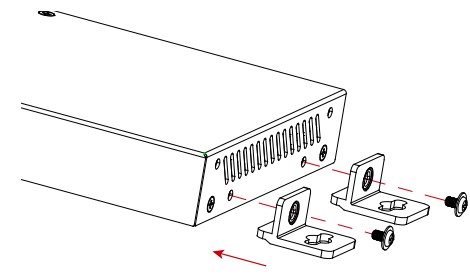
- Install the brackets on the position as desired using screws (not included).
Typical Applications
3.1. Application 1
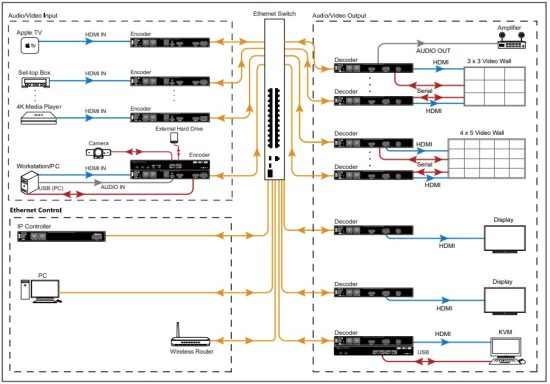 3.2. Application 2
3.2. Application 2
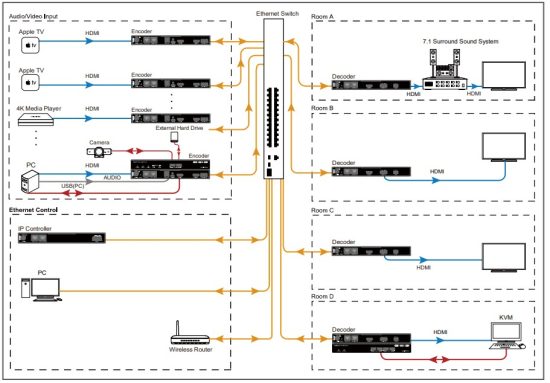 3.3. Application 3
3.3. Application 3 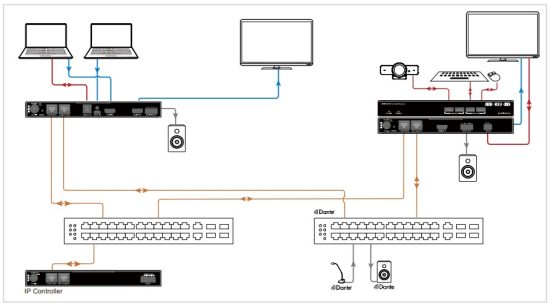 In this application, LAN1 (POE+) port is for transmission of A/V streams and control data; LAN2 is for transmission of Dante audio streams which is routed to a standalone network. Two Ethernet ports are connected to different networks.
In this application, LAN1 (POE+) port is for transmission of A/V streams and control data; LAN2 is for transmission of Dante audio streams which is routed to a standalone network. Two Ethernet ports are connected to different networks.
Hardware Installation
 Note: If the Ethernet switch doesn’t support PoE, connect encoders and decoders to their power adapters.
Note: If the Ethernet switch doesn’t support PoE, connect encoders and decoders to their power adapters.
IP Address Identification
Default IP setting for the device is DHCP. Ensure there’s a DHCP server in the network so that the device can obtain a valid IP address when you deploy the system. If DHCP server is not available, e.g. the device is connected to a laptop directly, the device gets a default IP address in the range of 169.254.X.Y. The allocated IP address can be identified through OSD or API Commands.
Input Switching Mode
The device provides three modes for input switching between USB-C IN and HDMI IN: Auto, Manual and Priority.
- Auto
(1) In Auto mode, the input switching follows “Last In First Out” rule, i.e. the device always switches to the later input source and outputs it.
When the selected video source is removed, the device will switch to another source automatically.
(2) If each input port is connected to a video source, power on the device, the device will select the video source according to the priority order (USB-C IN > HDMI IN).
For example, if a USB-C source is connected to USB-C IN, it will be selected as the input source; if not, the device will switch to the HDMI source. - Manual
In Manual mode, the device switches to the specified video source directly.
If the specified source is invalid (e.g. in standby state), the device doesn’t output signal. - Priority
In Priority mode, when each input port is connected to a video source, power on the device, the source with higher priority will be selected as input source. When the selected video source is removed, the device will switch to another video source automatically.
The priority for the two input ports can be defined through API commands.
Note:
- By default, the input switching mode is set as Auto.
- The input switching mode can be configured through API commands; for more information refer to the separate API document.
Control of Devices
The device can be controlled and configured by the IP controller, including routing of audio, video and USB signals, configurations of audio & video parameters, Dante features, firmware upgrade, etc. For more information, refer to the web configuration guide of the IP controller.
Customer Service
The return of a product to our Customer Service implies the full agreement of the terms and conditions hereinafter. There terms and conditions may be changed without prior notice.
8.1. Warranty
The limited warranty period of the product is fixed three years.
8.2. Scope
These terms and conditions of Customer Service apply to the customer service provided for the products or any other items sold by authorized distributor only.
8.3. Warranty Exclusion:
- Warranty expiration.
- Factory applied serial number has been altered or removed from the product.
- Damage, deterioration or malfunction caused by:
✔ Normal wear and tear.
✔ Use of supplies or parts not meeting our specifications.
✔ No certificate or invoice as the proof of warranty.
✔ The product model showed on the warranty card does not match with the model of the product for repairing or had been altered.
✔ Damage caused by force majeure.
✔ Servicing not authorized by distributor.
✔ Any other causes which does not relate to a product defect. - Shipping fees, installation or labor charges for installation or setup of the product.
8.4. Documentation:
Customer Service will accept defective product(s) in the scope of warranty coverage at the sole condition that the defeat has been clearly defined, and upon reception of the documents or copy of invoice, indicating the date of purchase, the type of product, the serial number, and the name of distributor.
Remarks: Please contact your local distributor for further assistance or solutions.
 syscomtec Distribution AG
syscomtec Distribution AG
Keltenring 11
D-82041 Oberhaching (bei München)
Tel.: +49 89 666 109 330
Email: post@syscomtec.com
https://www.syscomtec.com
Documents / Resources
 |
Syscomtec SCT-IPE5100 HDMI 2.0 USB AV over IP Encoder [pdf] User Manual SCT-IPE5100, SCT-IPE5100 HDMI 2.0 USB AV over IP Encoder, SCT-IPE5100, HDMI 2.0 USB AV over IP Encoder, USB AV over IP Encoder, IP Encoder, Encoder |